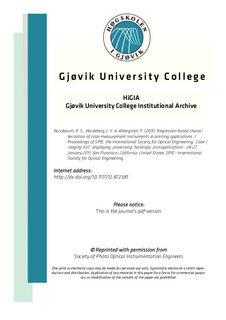| dc.contributor.author | Nussbaum, Peter Stefan | |
| dc.contributor.author | Hardeberg, Jon Yngve | |
| dc.contributor.author | Albregtsen, Fritz | |
| dc.date.accessioned | 2011-04-18T07:54:14Z | |
| dc.date.available | 2011-04-18T07:54:14Z | |
| dc.date.issued | 2011 | |
| dc.identifier.citation | Nussbaum, P. S., Hardeberg, J. Y. & Albregtsen, F. (2011). Regression based characterization of color measurement instruments in printing applications. I: Proceedings of SPIE, the International Society for Optical Engineering, Color imaging XVI : displaying, processing, hardcopy, and applications : 24-27 January 2011, San Francisco, California, United States, SPIE - International Society for Optical Engineering. | en_US |
| dc.identifier.isbn | 9780819484031 | en_US |
| dc.identifier.issn | 0277-786X | |
| dc.identifier.uri | http://hdl.handle.net/11250/142518 | |
| dc.description | This is the copy of journal's version originally published in Proc. SPIE 7866: http://spie.org/x10.xml?WT.svl=tn7. Reprinted with permission of SPIE. | en_US |
| dc.description.abstract | In the context of print quality and process control colorimetric parameters and tolerance values are clearly defined. Calibration procedures are well defined for color measurement instruments in printing workflows. Still, using more than one color measurement instrument measuring the same color wedge can produce clearly different results due to random and systematic errors of the instruments. In certain situations where one instrument gives values which are just inside the given tolerances and another measurement instrument produces values which exceed the predefined tolerance parameters, the question arises whether the print or proof is approved or not accepted with regards to the standard parameters. The aim of this paper was to determine an appropriate model to characterize color measurement instruments for printing applications in order to improve the colorimetric performance and hence the inter-instrument agreement. The method proposed is derived from color image acquisition device characterization methods which have been applied by performing polynomial regression with a least square technique. Six commercial color measurement instruments were used for measuring color patches of a control color wedge on three different types of paper substrates. The characterization functions were derived using least square polynomial regression, based on the training set of 14 BCRA tiles colorimetric reference values and the corresponding colorimetric measurements obtained by the measurement instruments. The derived functions were then used to correct the colorimetric values of test sets of 46 measurements of the color control wedge patches. The corrected measurement results obtained from the applied regression model was then used as the starting point with which the corrected measurements from other instruments were compared to find the most appropriate polynomial, which results in the least color difference. The obtained results demonstrate that the proposed regression method works remarkably well with a range of different color measurement instruments used on three types of substrates. Finally, by extending the training set from 14 samples to 38 samples the obtained results clearly indicate that the model is robust. | en_US |
| dc.language.iso | eng | en_US |
| dc.publisher | Society of Photo Optical Instrumentation Engineers (SPIE) | en_US |
| dc.relation.ispartofseries | Proceedings of SPIE;7866 | |
| dc.title | Regression based characterization of color measurement instruments in printing applications | en_US |
| dc.type | Journal article | en_US |
| dc.type | Peer reviewed | en_US |
| dc.subject.nsi | VDP::Mathematics and natural science: 400::Information and communication science: 420::Simulation, visualization, signal processing, image processing: 429 | en_US |
| dc.source.pagenumber | 15 | en_US |
| dc.identifier.doi | http://dx.doi.org/10.1117/12.872381 | en_US |
